Indicators of Sustainable Forestry: Methodological Approaches for Impact Assessments across Swedish Forestry
Abstract
:1. Introduction
2. Materials and Methods
2.1. Basic Principles and System Boundaries
2.2. Choice of Reference Scenarios
2.3. Forest Scenarios
- Scenario 1:
- Current forest management
- Scenario 2:
- Increased forest growth and harvests
- Scenario 3:
- Double conservation areas
2.4. Choice of Indicators
- Impact on biodiversity;
- Impact on climate change, separated into fossil and biogenic origin;
- Impact on the recreational values of the forest;
- Impact on the economic revenues of the forest owner.
2.5. Indicator Calculations
2.5.1. Biodiversity
- (1)
- Stands with old trees. The average tree age in the stand should be above 140 years in northern Sweden and above 120 years in southern Sweden;
- (2)
- Stands with dead wood. There should be more than 20 m3 of dead wood per hectare, including only dead wood with a diameter greater than 20 cm;
- (3)
- Stands with large trees. There should be more than 60 trees per hectare with a diameter greater than 45 cm for Norway spruce, Scots pine, and southern broadleaves and a diameter greater than 35 cm for other tree species;
- (4)
- Mixed deciduous and coniferous tree species. The average tree age in the stand should be above 80 years, and more than 3/10 of the basal area should be deciduous tree species;
- (5)
- Stands that are managed with continuous cover forestry, i.e., with no final fellings.
2.5.2. Climate Change (Biogenic)
2.5.3. Climate Change (Fossil)
2.5.4. Social (Recreational Values)
2.5.5. Economic Revenues
2.6. Normalization to a Common Scale
2.7. Integration and Visualization
3. Results and Discussion
3.1. Timber Production
3.2. Impact on Biodiversity
3.3. Impact on Climate Change (Biogenic)
3.4. Impact on Climate Change (Fossil)
3.5. Impacts on Recreation Values
3.6. Impacts on Economic Values
3.7. Integration of Results for Different Indicators
4. Discussion
5. Conclusions and Future Research
Author Contributions
Funding
Informed Consent Statement
Data Availability Statement
Acknowledgments
Conflicts of Interest
Correction Statement
References
- Maes, J.; Bruzón, A.G.; Barredo, J.I.; Vallecillo, S.; Vogt, P.; Rivero, I.M.; Santos-Martín, F. Accounting for forest condition in Europe based on an international statistical standard. Nat. Commun. 2023, 14, 3723. [Google Scholar] [CrossRef]
- Skytt, T.; Englund, G.; Jonsson, B.G. Climate mitigation forestry—Temporal trade-offs. Environ. Res. Lett. 2021, 16, 114037. [Google Scholar] [CrossRef]
- Lundmark, T.; Bergh, J.; Hofer, P.; Lundström, A.; Nordin, A.; Poudel, B.; Sathre, R.; Taverna, R.; Werner, F. Potential roles of Swedish forestry in the context of climate change mitigation. Forests 2014, 5, 557–578. [Google Scholar] [CrossRef]
- Soimakallio, S.; Kalliokoski, T.; Lehtonen, A.; Salminen, O. On the trade-offs and synergies between forest carbon sequestration and substitution Mitig. Adapt. Strateg. Glob. Chang. 2021, 26, 4. [Google Scholar] [CrossRef]
- Karvonen, J.; Halder, P.; Kangas, J.; Leskinen, P. Indicators and tools for assessing sustainability impacts of the forest bioeconomy. For. Ecosyst. 2017, 4, 2. [Google Scholar] [CrossRef]
- Petersson, H.; Ellison, D.; Appiah Mensah, A.; Berndes, G.; Egnell, G.; Lundblad, M.; Lundmark, T.; Lundström, A.; Stendahl, J.; Wikberg, P. On the role of forests and the forest sector for climate change mitigation in Sweden. GCB Bioenergy 2022, 14, 793–813. [Google Scholar] [CrossRef]
- Päivinen, R.; Lindner, M.; Rosén, K.; Lexer, M.J. A concept for assessing sustainability impacts of forestry-wood chains. Eur. J. For. Res. 2012, 131, 7–19. [Google Scholar] [CrossRef]
- Lindner, M.; Suominen, T.; Palosuo, T.; Garcia-Gonzalo, J.; Verweij, P.; Zudin, S.; Päivinen, R. ToSIA—A Tool for Sustainability Impact Assessment of Forest Wood Chains. Ecol. Model. 2010, 221, 2197–2205. [Google Scholar] [CrossRef]
- Palosuo, T.; Suominen, T.; Werhahn-Mees, W.; Garcia-Gonzalo, J.; Lindner, M. Assigning results of the Tool for Sustainability Impact Assessment (ToSIA) to products of a forest-wood-chain. Ecol. Model. 2010, 221, 2215–2225. [Google Scholar] [CrossRef]
- Lindner, M.; Werhahn-Mees, W.; Suominen, T.; Vötter, D.; Zudin, S.; Pekkanen, M.; Pizzirani, S. Conducting sustainability impact assessments of forestry-wood chains: Examples of ToSIA applications. Eur. J. For. Res. 2012, 131, 21–34. [Google Scholar] [CrossRef]
- Pang, X.; Nordström, E.-M.; Böttcher, H.; Trubins, R.; Mörtberg, U. Trade-offs and synergies among ecosystem services under different forest management scenarios—The LEcA tool. Ecosyst. Serv. 2017, 28, 67–79. [Google Scholar] [CrossRef]
- European Forest Institute. Implementing Criteria and Indicators for Sustainable Forest Management in Europe; European Forest Institute: Joensuu, Finland, 2013. [Google Scholar]
- Forest Europe, 2020: State of Europe’s Forest 2020. Available online: https://foresteurope.org/wp-content/uploads/2016/08/SoEF_2020.pdf (accessed on 23 March 2024).
- Eriksson, L.; Klapwijk, M.J. Attitudes towards biodiversity conservation and carbon substitution in forestry: A study of stakeholders in Sweden. For. Int. J. For. Res. 2019, 92, 219–229. [Google Scholar] [CrossRef]
- Krumm, F.; Rigling, A.; Bollmann, K.; Brang, P.; Dürr, C.; Gessler, A.; Schuck, A.; Schulz-Marty, T.; Winkel, G. Synthesis: Improving biodiversity conservation in European managed forests needs pragmatic, courageous, and regionally-rooted management approaches. In How to Balance Forestry and Biodiversity Conservation—A View across Europe; Krumm, F., Schuck, A., Rigling, A., Eds.; European Forest Institute (EFI): Joensuu, Finland; Swiss Federal Institute for Forest, Snow and Landscape Research (WSL): Birmensdorf, Switzerland, 2020; pp. 609–633. [Google Scholar]
- SME. Revised National Forestry Accounting Plan for Sweden; Government Offices of Sweden, Ministry for the Environment: Stockholm, Sweden, 2019. [Google Scholar]
- Andersson, M.; Bostedt, G.; Sandström, C. The role of Swedish forests in climate change mitigation—A frame analysis of conflicting interests. For. Policy Econ. 2022, 144, 102842. [Google Scholar] [CrossRef]
- Swedish Forest Agency. Forest Management in Sweden. Current Practice and Historical Background. Report 2020/4. 2020. Available online: https://www.skogsstyrelsen.se/globalassets/om-oss/rapporter/rapporter-20222021202020192018/rapport-2020-4-forest-management-in-sweden.pdf (accessed on 10 April 2024).
- UNECE. Forest Products Annual Market Review 2019–2020; FAO: Rome, Italy, 2020; Available online: https://unece.org/fileadmin/DAM/timber/publications/2020/SP-50.pdf (accessed on 18 December 2023).
- Swedish Forest Industries 2022. Facts and Figures. Available online: https://www.forestindustries.se/forest-industry/statistics/facts-and-figures/ (accessed on 2 April 2024).
- Lindahl, K.B.; Sténs, A.; Sandström, C.; Johansson, J.; Lidskog, R.; Ranius, T.; Roberge, J.-M. The Swedish forestry model: More of everything? For. Policy Econ. 2017, 77, 44–55. [Google Scholar] [CrossRef]
- Eggers, J.; Melin, Y.; Lundström, J.; Bergström, D.; Öhman, K. Management strategies for wood fuel harvesting—Trade-offs with biodiversity and forest ecosystem services. Sustainability 2020, 12, 4089. [Google Scholar] [CrossRef]
- Soimakallio, S.; Cowie, A.; Brandão, M.; Finnveden, G.; Erlandsson, M.; Koponen, K.; Karlsson, P.-E. Attributional Life Cycle Assessment: Is a land-use baseline necessary? Int. J. Life Cycle Assess. 2015, 20, 1364–1375. [Google Scholar] [CrossRef]
- Eliasson, P.; Svensson, M.; Olsson, M.; Ågren, G.I. Forest carbon balances at the landscape scale investigated with the Q model and the CoupModel—Responses to intensified harvests. For. Ecol. Manag. 2013, 290, 67–78. [Google Scholar] [CrossRef]
- Cintas, O.; Berndes, G.; Cowie, A.L.; Egnell, G.; Holmstrom, H.; Ågren, G.I. The climate effect of increased forest bioenergy use in Sweden: Evaluation at different spatial and temporal scales. Wiley Interdiscip. Rev. Energy Environ. 2015, 5, 351–369. [Google Scholar] [CrossRef]
- D’amato, D.; Li, N.; Rekola, M.; Toppinen, A.; Lu, F.-F. Linking forest ecosystem services to corporate sustainability disclosure: A conceptual analysis. Ecos. Serv. 2015, 14, 170–178. [Google Scholar] [CrossRef]
- KSLA. Forests and Forestry in Sweden. The Royal Swedish Academy of Agriculture and Forestry. 2015. Available online: https://www.ksla.se/wp-content/uploads/2015/08/Forests-and-Forestry-in-Sweden_2015.pdf (accessed on 18 December 2023).
- Swedish Forest Agency. Swedish Forestry Act. In Skogsvårdslagstiftningen; Swedish Forest Agency: Jönköping, Sweden, 1993. [Google Scholar]
- Wikström, P.; Edenius, L.; Elfving, B.; Eriksson, L.O.; Lämås, T.; Sonesson, J.; Öhman, K.; Wallerman, J.; Waller, C.; Klintebäck, F. The Heureka forestry decision support system: An overview. Math. Comput. For. Nat.-Resour. Sci. 2011, 3, 87–95. [Google Scholar]
- Lämås, T.; Saengstuvall, L.; Öhman, K.; Lundström, J.; Årevall, J.; Holmström, H.; Nilsson, L.; Nordström, E.-M.; Wikberg, P.-E.; Wikström, P.; et al. The multifaceted Swedish Heureka forest decision support system: Context, functionality, design, and 10 years experiences of its use. Front. For. Glob. Chang. 2023, 6, 1163105. [Google Scholar] [CrossRef]
- Akselsson, C.; Belyazid, S. Critical biomass harvesting—Applying a new concept for Swedish forest soils. For. Ecol. Manag. 2018, 409, 67–73. [Google Scholar] [CrossRef]
- Kronberg, R.M.; Drott, A.; Jiskra, M.J.G.; Wiederhold, J.G.; Björn, E.; Skyllberg, U. Forest harvest contribution to Boreal freshwater methylmercury load. Glob. Biogeochem. Cycles 2016, 30, 825–843. [Google Scholar] [CrossRef]
- Löfgren, S.; Fröberg, M.; Yu, J.; Nisell, J.; Ranneby, B. Water chemistry in 179 randomly selected Swedish headwater streams related to forest production, clear-felling and climate. Environ. Monit. Assess. 2014, 186, 8907–8928. [Google Scholar] [CrossRef] [PubMed]
- Ćosović, M.; Bugalho, M.N.; Thom, D.; Borges, J.G. Stand Structural Characteristics Are the Most Practical Biodiversity Indicators for Forest Management Planning in Europe. Forests 2020, 11, 343. [Google Scholar] [CrossRef]
- Gao, T.; Hedblom, M.; Emilsson, T.; Nielsen, A.B. The role of forest stand structure as biodiversity indicator. For. Ecol. Manag. 2014, 330, 82–93. [Google Scholar] [CrossRef]
- Swedish Forest Agency. Indikatorer för Miljökvalitetsmålet Levande Skogar. Report 2019/01. Available online: https://www.skogsstyrelsen.se/globalassets/om-oss/rapporter/rapporter-20222021202020192018/rapport-2019-01-indikatorer-for-miljokvalitetsmalet-levande-skogar.pdf (accessed on 22 November 2021).
- UNFCCC, 2023. Reporting and Accounting of LULUCF Activities under the Kyoto Protocol. Available online: https://unfccc.int/topics/land-use/workstreams/lulucf-under-the-kyoto-protocol/reporting-and-accounting-of-lulucf-activities-under-the-kyoto-protocol (accessed on 18 December 2023).
- Ågren, K.; Högbom, L.; Johansson, M.; Och Wilhelmsson, L. Datainsamling till Underlag för Livscykelanalyser (LCA) av det Svenska Skogsbruket. Skogforsk ARBETSRAPPORT 1086–2021. ISSN 1404-305X. Available online: https://www.skogforsk.se/cd_20220118135001/contentassets/726c298c5aa846b68f140b8d428660cb/arbetsrapport-1086-2021-lca.pdf (accessed on 10 February 2024).
- Lindhagen, A. Forest Recreation in Sweden: Four Case Studies Using Quantitative and Qualitative Methods; SLU Department of Environmental Forestry: Alnarp, Sweden, 1996. [Google Scholar]
- Karlsson, P.E.; Mattsson, E.; Erlandsson, M.; Nilsson, Å.; Holmström, H. Indikatorer för Hållbarhetsbedömningar av Svenskt Skogsbruk och Skogsindustriella Produkter; IVL Rapport C612; IVL Svenska Miljöinstitutet: Göteborg, Sweden, 2021. [Google Scholar]
- Mattsson, E.; Erlandsson, M.; Karlsson, P.E.; Holmström, H. A conceptual landscape-level approach to assess the impacts of forestry on biodiversity. Sustainability 2022, 14, 4214. [Google Scholar] [CrossRef]
- Swedish, E.P.A.; National Inventory Report Sweden 2022. Greenhouse Gas Emission Inventories 1990–2020. 2022. Available online: https://unfccc.int/documents/461776 (accessed on 18 December 2023).
- Hellsten, S.; Stadmark, J.; Karlsson, G.P.; Karlsson, P.E.; Akselsson, C. Increased concentrations of nitrate in forest soil water after windthrow in southern Sweden. For. Ecol. Manag. 2015, 356, 234–242. [Google Scholar] [CrossRef]
- Päivinen, R.; Lindner, M. Assessment of sustainability of forest-wood chains. In The Multifunctional Role of Forests—Policies, Methods and Case Studies; Cesaro, L., Gatto, P., Pettenella, D., Eds.; EFI Proceedings 55; European Forest Institute: Joensuu, Finland, 2008; pp. 153–160. [Google Scholar]
- Schulte, M.; Jonsson, R.; Hammar, T.; Stendahl, J.; Hansson, P.A. Nordic forest management towards climate change mitigation: Time dynamic temperature change impacts of wood product systems including substitution effects. Eur. J. For. Res. 2022, 141, 845–863. [Google Scholar] [CrossRef]
- Backman, F.; Mårald, E. Is there a Nordic Model for the treatment of introduced tree species? A comparison of the use, policy, and debate concerning introduced tree species in the Nordic countries. Scand. J. For. Res. 2016, 31, 222–232. [Google Scholar] [CrossRef]
- Beland Lindahl, K.; Westholm, E.; Kraxner, F. Nordic forest futures—An introduction. In The Future Use of Nordic Forests; A Global Perspective; Westholm, E., Beland Lindahl, K., Kraxner, F., Eds.; Springer: Cham, Switzerland, 2015. [Google Scholar]
- Juutinen, A.; Kurttila, M.; Pohjanmies, T.; Tolvanen, A.; Kuhlmey, K.; Skudnik, M.; Triplat, M.; Westin, K.; Mäkipää, R. Forest owners’ preferences for contract-based management to enhance environmental values versus timber production. For. Policy Econ. 2021, 132, 102587. [Google Scholar] [CrossRef]
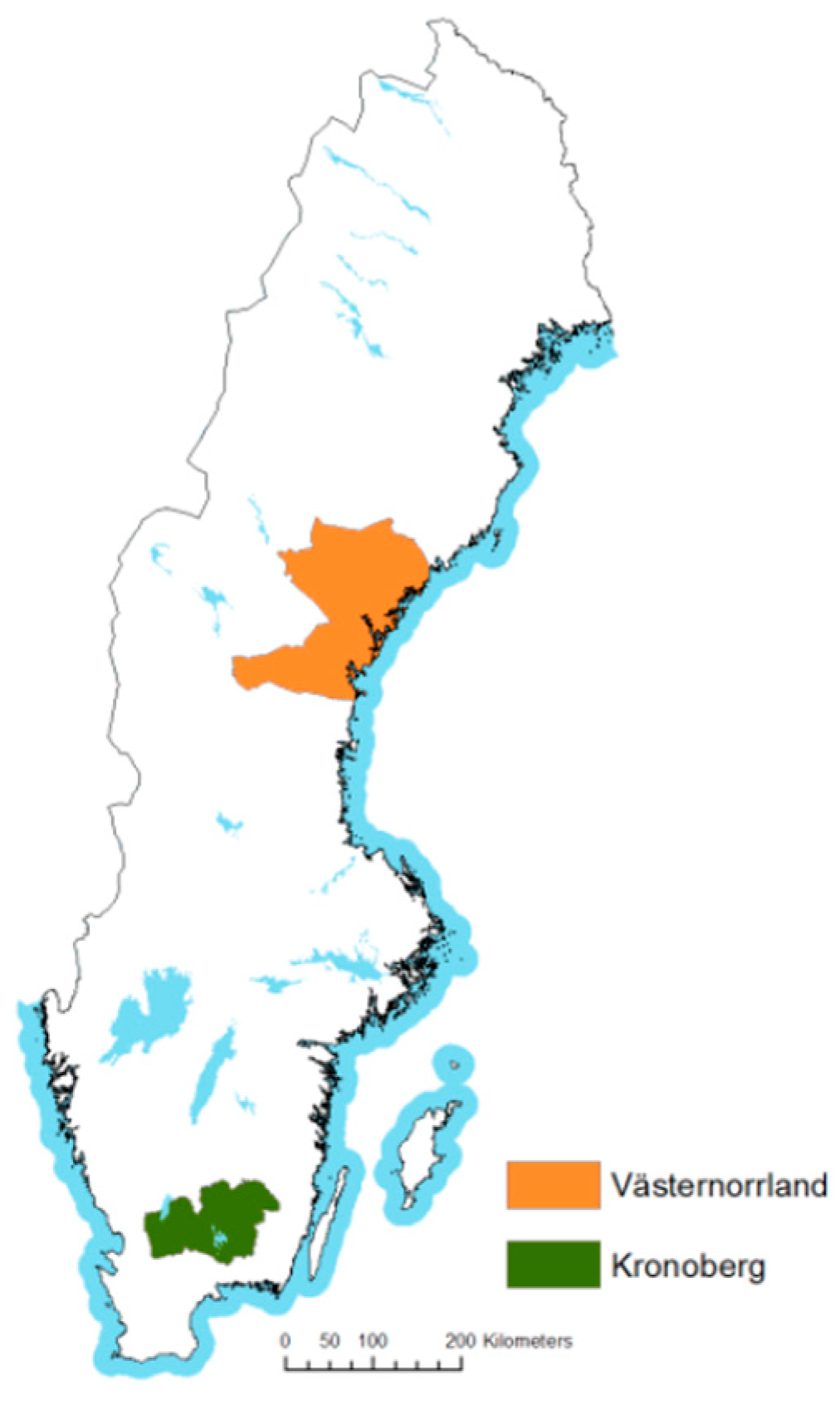


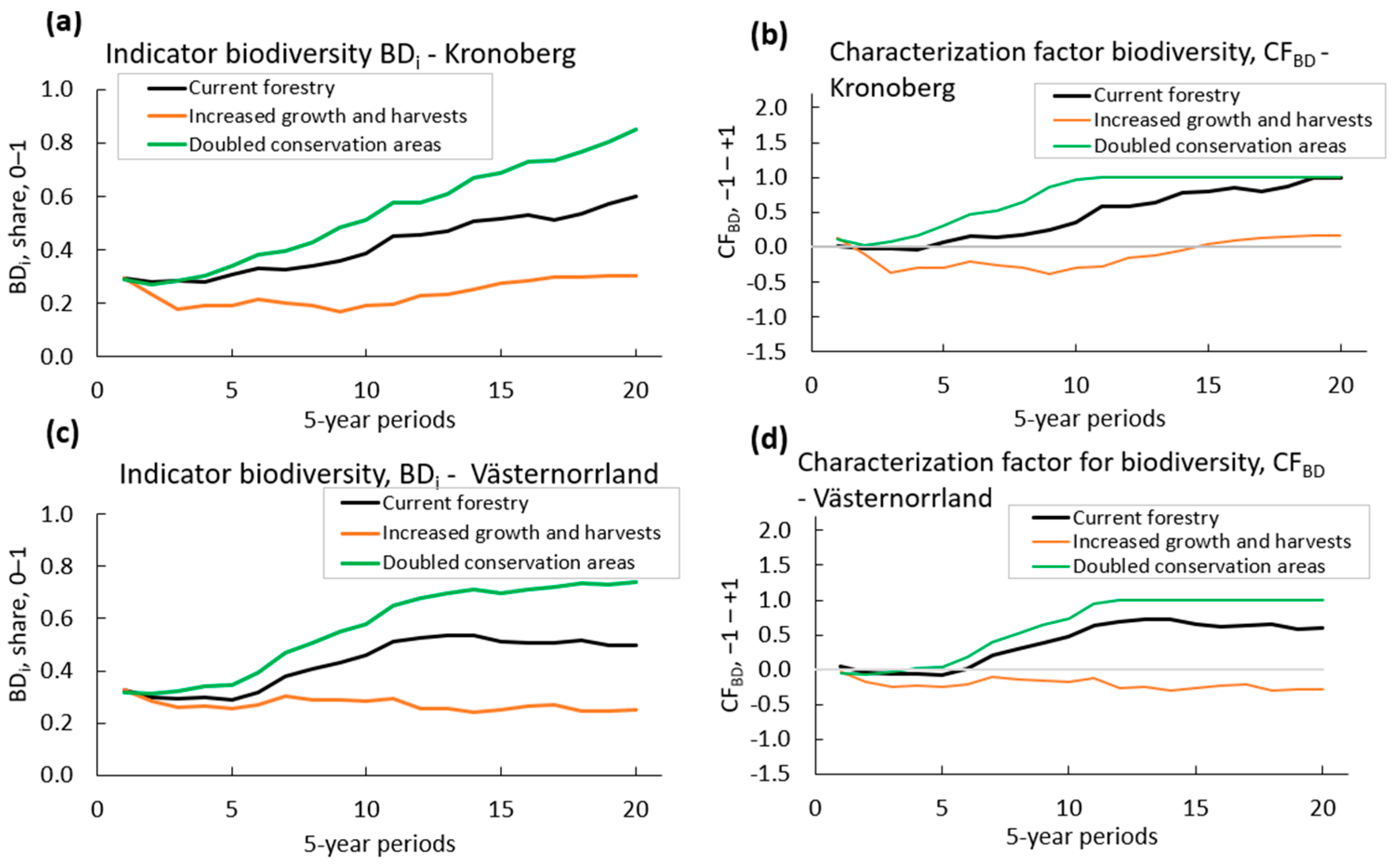
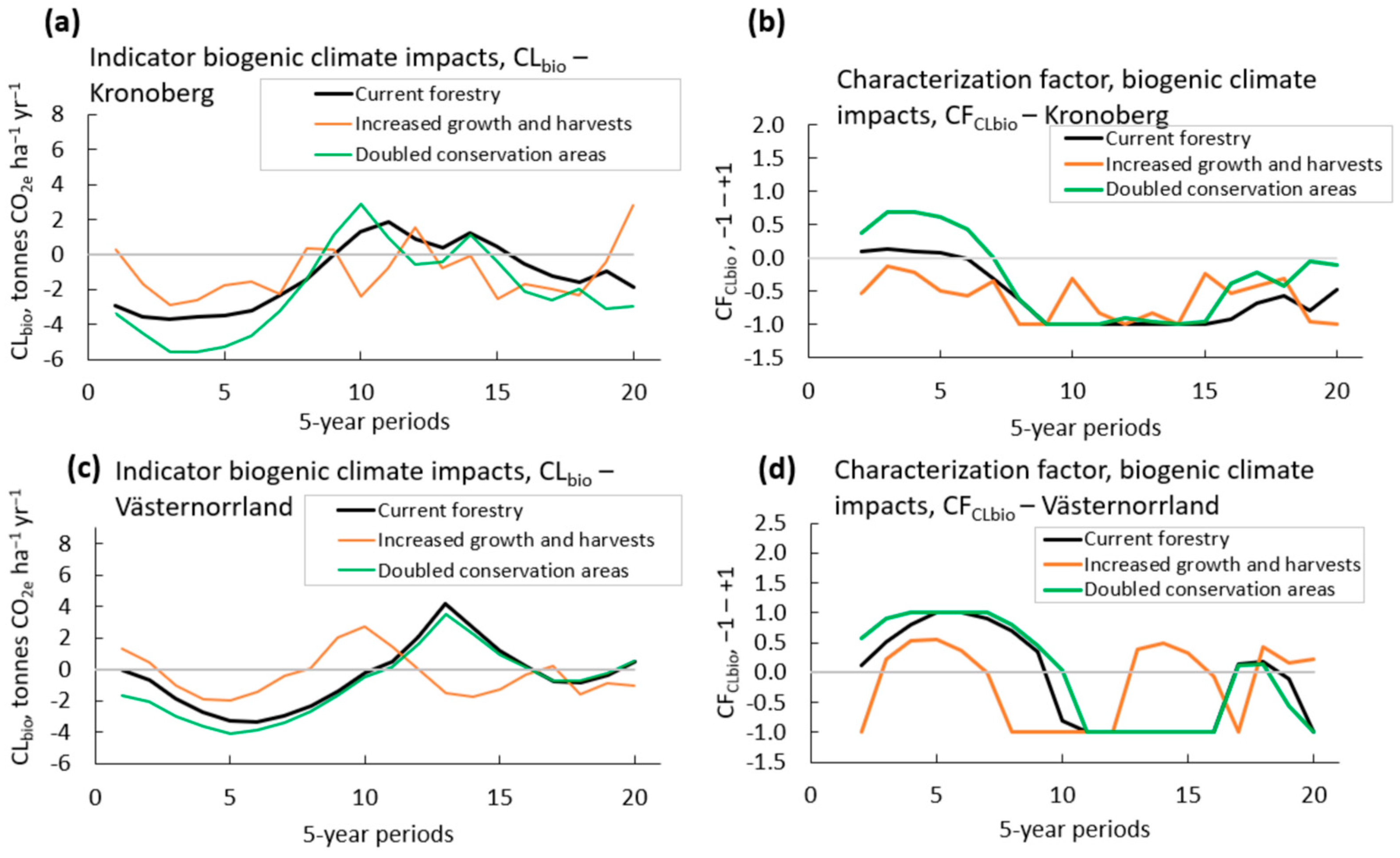


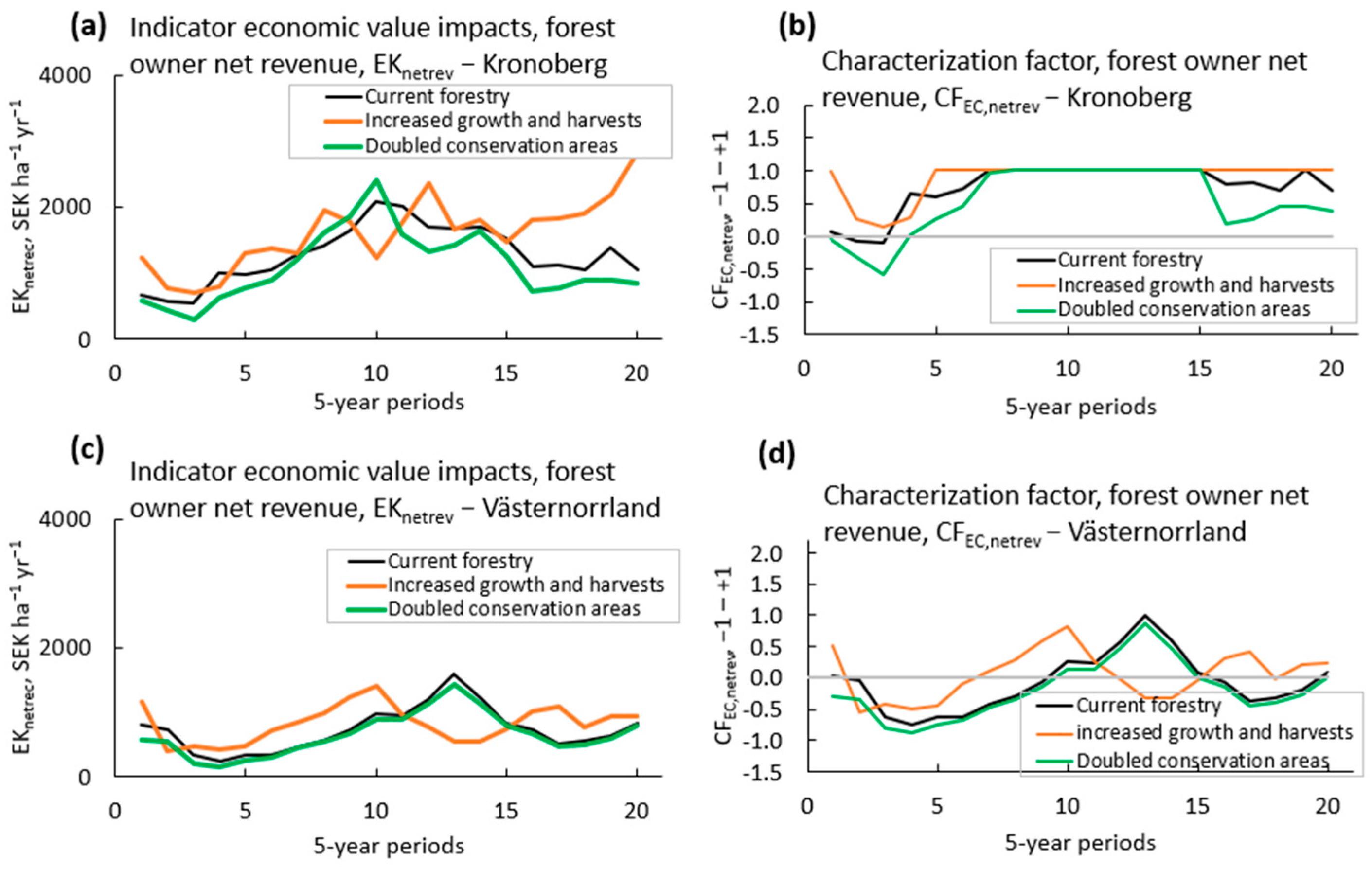
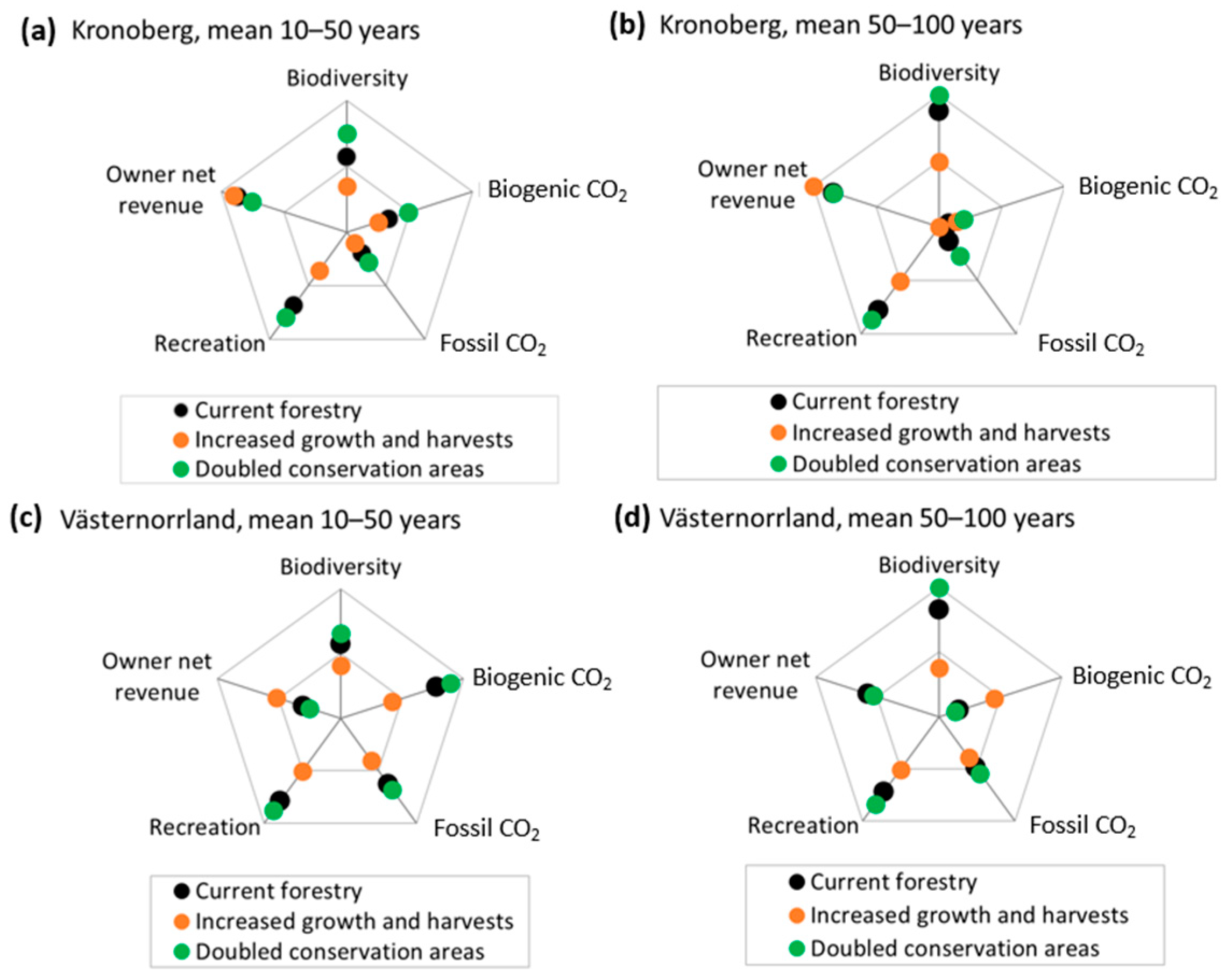
| Indicator | Unit | Reference Value | Preference Value | Indifference Value | Preference | Indifference |
|---|---|---|---|---|---|---|
| Biodiversity | Fraction of the total area of productive forest | 0.29/0.31 | 0.57/0.63 | 0.029/0.031 | Double reference value | 10% of reference value |
| Climate (biogenic) | Tonnes CO2e ha−1 yr−1 | 3.27/0.37 | 6.54/3.27 | 0.33/0.164 | Kronoberg: Double reference value. Västernorrland: 50% of the Kronoberg preference value * | Kronoberg: 10% of reference value. Västernorrland: 50% of the Kronoberg preference value * |
| Climate (fossil) | Tonnes CO2e ha−1 yr−1 | 0.0135/0.016 | 0.0013/0.0016 | 0.0270/0.031 | 10% of reference value | Double reference value |
| Social (recreation) | Fraction of the total area productive forest | 0.43/0.35 | 0.87/0.70 | 0.043/0.035 | Double reference value | 10% of reference value |
| Economic (net income) | SEK ha−1 yr−1 | 613/772 | 1227/1543 | 61/77 | Double reference value | 10% of reference value |
| Current Forestry | Increased Growth and Harvests | Doubled Conservation Areas | |
|---|---|---|---|
| Kronoberg, 10–50 years | 0.99 | 1.10 | 0.93 |
| Kronoberg, 50–100 years | 1.08 | 1.47 | 0.89 |
| Västernorrland, 10–50 years | 0.49 | 0.76 | 0.42 |
| Västernorrland, 50–100 years | 0.73 | 0.77 | 0.67 |
| Current Forestry | Increased Growth and Harvests | Doubled Conservation Areas | |
|---|---|---|---|
| Kronoberg, 10–50 years | 0.33 | 0.19 | 0.39 |
| Kronoberg, 50–100 years | 0.52 | 0.27 | 0.70 |
| Västernorrland, 10–50 years | 0.36 | 0.28 | 0.44 |
| Västernorrland, 50–100 years | 0.52 | 0.26 | 0.71 |
| Current Forestry | Increased Growth and Harvests | Double Conservation Areas | |
|---|---|---|---|
| Kronoberg, 10–50 years | −2.06 | −1.61 | −2.72 |
| Kronoberg, 50–100 years | −0.15 | −0.64 | −1.22 |
| Västernorrland, 10–50 years | −2.27 | −0.25 | −2.86 |
| Västernorrland, 50–100 years | 0.92 | −0.67 | 0.74 |
| Current Forestry | Increased Growth and Harvests | Double Conservation Areas | |
|---|---|---|---|
| Kronoberg, 10–50 years | 0.022 | 0.027 | 0.020 |
| Kronoberg, 50–100 years | 0.024 | 0.036 | 0.020 |
| Västernorrland, 10–50 years | 0.012 | 0.019 | 0.011 |
| Västernorrland, 50–100 years | 0.016 | 0.019 | 0.015 |
| Current Forestry | Increased Growth and Harvests | Double Conservation Areas | |
|---|---|---|---|
| Kronoberg, 10–50 years | 0.60 | 0.32 | 0.69 |
| Kronoberg, 50–100 years | 0.67 | 0.44 | 0.76 |
| Västernorrland, 10–50 years | 0.56 | 0.36 | 0.62 |
| Västernorrland, 50–100 years | 0.50 | 0.37 | 0.59 |
| Current Forestry | Increased Growth and Harvests | Double Conservation Areas | |
|---|---|---|---|
| Kronoberg, 10–50 years | 1251 | 1303 | 1206 |
| Kronoberg, 50–100 years | 1428 | 1957 | 1137 |
| Västernorrland, 10–50 years | 497 | 818 | 430 |
| Västernorrland, 50–100 years | 906 | 830 | 835 |
Disclaimer/Publisher’s Note: The statements, opinions and data contained in all publications are solely those of the individual author(s) and contributor(s) and not of MDPI and/or the editor(s). MDPI and/or the editor(s) disclaim responsibility for any injury to people or property resulting from any ideas, methods, instructions or products referred to in the content. |
© 2024 by the authors. Licensee MDPI, Basel, Switzerland. This article is an open access article distributed under the terms and conditions of the Creative Commons Attribution (CC BY) license (https://creativecommons.org/licenses/by/4.0/).
Share and Cite
Mattsson, E.; Karlsson, P.E.; Erlandsson, M.; Nilsson, Å.; Holmström, H. Indicators of Sustainable Forestry: Methodological Approaches for Impact Assessments across Swedish Forestry. Sustainability 2024, 16, 3331. https://doi.org/10.3390/su16083331
Mattsson E, Karlsson PE, Erlandsson M, Nilsson Å, Holmström H. Indicators of Sustainable Forestry: Methodological Approaches for Impact Assessments across Swedish Forestry. Sustainability. 2024; 16(8):3331. https://doi.org/10.3390/su16083331
Chicago/Turabian StyleMattsson, Eskil, Per Erik Karlsson, Martin Erlandsson, Åsa Nilsson, and Hampus Holmström. 2024. "Indicators of Sustainable Forestry: Methodological Approaches for Impact Assessments across Swedish Forestry" Sustainability 16, no. 8: 3331. https://doi.org/10.3390/su16083331






